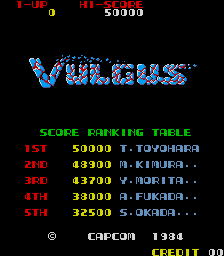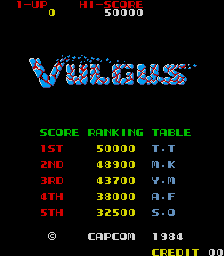Vulgus
| Vulgus |
|---|
|
Developer: Capcom
|
The first of many, many Capcom games.
Contents
Unused Graphics
![]()
![]()
Unused point values of 8,000 and 50,000. The only monster that could reasonably be worth 50,000 points is the Vulgus itself, but it only gives 10,000.
![]()
A full set of lowercase letters that aren't used anywhere, a tradition carried by titles where Tokuro Fujiwara had involvement (although Yoshiki Okamoto directed this game).
![]()
Found at the tail end of the game's font are graphics of a tiny man and woman. These later appeared in Pirate Ship Higemaru's font as high score characters.
![]()
Stored with the rest of the object graphics are two Kanji tiles.
得郎 would refer to Tokuro Fujiwara, which is weird since he isn't the director.
Regional Differences
Title Screen
| Set 1/Japan? | Set 2 |
|---|---|
 |
 |
Both the presumed Japanese version (vulgusj in MAME) and Set 1 (vulgus) allow for up to 10 characters in the high score list and give the full last names of the game's staff.
The other version, Set 2 (vulgusa), cuts off the staff names and only allows 3 characters per name, presumably to prevent people from writing something filthy in there.
Graphics Memory
For whatever reason, the graphics in Set 2 are rotated 180° compared to how they're stored in Set 1 and the presumed Japanese version.
Revisional Differences
Set 1 is assumed to be a Japanese revision of the game because of its 10-character high score entries and because it doesn't store the graphics backwards. There are also code differences that support this being an early version of the Japan set.
Vulgus Exploit
This game has a looping set of stages: Desert, Space, Jungle, Space, Arctic, and Vulgus.
In Set 1 only, there's an exploit/bug the player can use to fight Vulgus multiple times: If the player dies after fighting Vulgus but before entering the Desert area, they will spawn in the Arctic section instead. From there, the player is just one stage away from fighting Vulgus again. This trick can be done multiple times provided that the player has enough lives.
All sets besides Set 1 have an additional counter, E01F. This is initialized at 00 at the start of every life and will change to FF when the player enters a new area. When the player destroys Vulgus, 01 is added to the counter. So, if the player goes from the second Space stage to the Arctic stage without dying and defeats Vulgus, the counter will overflow to 00.
Now, if the counter is 01 and the player dies, they will immediately start at the Desert part of the stage loop. This ensures that the player can only fight Vulgus a maximum of twice per loop.
Game Demos
All of the gameplay demos from Set 1 were rerecorded for the other two sets.
Demo 1
| Set 1 | Others |
|---|---|
The Set 1 demo is slightly longer than the new demo.
Demo 2
| Set 1 | Others |
|---|---|
The old demo is barely 10 seconds long, while the new demo lasts 1 minute and 20 seconds!
Demo 3
| Set 1 | Others |
|---|---|
Neither of these demos is really that long, but the new demo is still twice as long.
References
Cleanup > Pages missing developer references
Games > Games by content > Games with regional differences
Games > Games by content > Games with revisional differences
Games > Games by content > Games with unused graphics
Games > Games by developer > Games developed by Capcom
Games > Games by platform > Arcade games
Games > Games by publisher > Games published by Capcom
Games > Games by publisher > Games published by SNK
Games > Games by release date > Games released in 1984
Games > Games by release date > Games released in July
Games > Games by release date > Games released in May